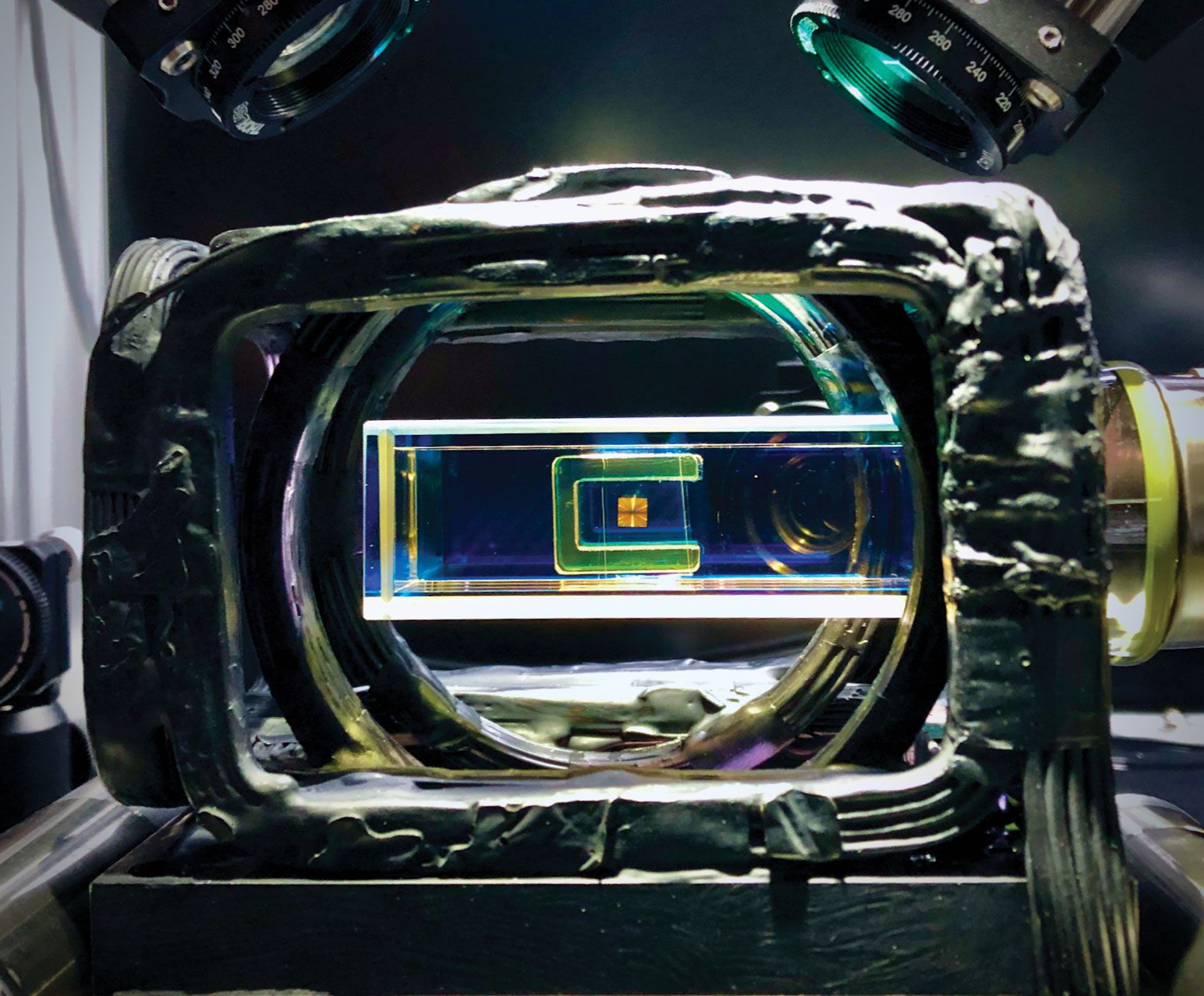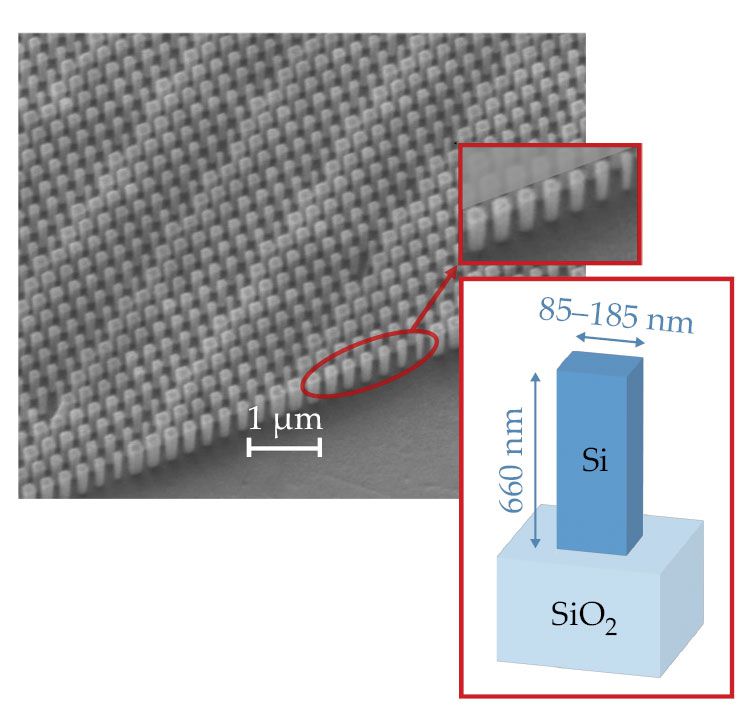A metamaterial lens traps atoms
DOI: 10.1063/PT.3.5096
Atoms are not always small. When excited to a Rydberg state—in which the outermost electron occupies a diffuse orbital that’s barely bound to the nucleus—an atom can have macroscopic dimensions of a millimeter or more. Rydberg states’ large size and polarizability make them an important tool of atomic physics because they offer researchers a way of controllably switching interactions on and off between atoms in neighboring optical traps. (See the article by David Weiss and Mark Saffman, Physics Today, July 2017, page 44
But if an atom is to be stably excited into a Rydberg state, it needs to be held at least several millimeters away from any solid surface, including the surface of the lens that’s used to focus the trapping light. For a typical trap size of 1 µm, that’s like confining an object to a spot the size of a golf ball from the opposite end of a football field. Conventional optics can meet that demanding requirement, but the precision lenses can take months to design and manufacture, and they must be tailor-made for each new experiment.
Now Cindy Regal of JILA in Boulder, Colorado, and her colleagues have shown that there might be another way.
1
They’ve created an array of optical traps for single rubidium atoms by focusing light not with smoothly curved glass lenses but with a metasurface, the orange square at the center of figure
Figure 1. A vacuum chamber for trapping atoms doesn’t leave much room for bulky multielement optics. By focusing light instead with a metasurface lens—the central orange square, just 4 mm on a side—researchers can make their experiments significantly more compact. (Courtesy of Ting-Wei Hsu, Scott Papp, and Cindy Regal.) Figure 2. A metasurface lens consists of a layer of fused silica topped with an array of amorphous silicon pillars. The size and spacing of the pillars are chosen so that when the pillars scatter incident light, the interference pattern mimics the focusing effect of a conventional lens. (Adapted from ref. 



Metasurface optics have been used for years to focus and manipulate light. (See the article by Kai Wang, Maria Chekhova, and Yuri Kivshar, Physics Today, August 2022, page 38
Faraway traps
A simple convex lens, with spherical curvature on both faces, only approximately focuses light to a point. Its performance is marred by chromatic aberration and spherical aberration, whereby light that has different colors or that strikes the lens in different places is focused to slightly different spots. For many physics experiments that use narrow monochromatic laser beams, simple lenses suffice. But for atom-trapping experiments, which require pinpoint focusing accuracy and often use multiple wavelengths for trapping and imaging, they do not.
One solution is to use aspheric lenses, which can be purchased commercially. But for the greatest flexibility, many researchers opt for multielement lenses, in which several simple lenses are stacked together in a column like a microscope objective. As a general rule, for each additional experimental requirement, such as an additional wavelength or constraint on the trap size, another element must be added to the lens. “So the system gets really big, really fast,” says Regal. “You often need huge lenses to do everything you want.”
Bulky multielement lenses are complicated to produce, and they constrain experiment design. They are tricky to fit inside the vacuum chamber with the atoms—not just because they are too big, but also because the air pockets between the lens elements are hard to evacuate. As a result, their focal lengths have to be even longer.
Metasurface optics, in contrast, are admirably compact: The square in figure
Last year Tongcang Li of Purdue University led a collaboration that used a metasurface lens to optically trap a nanoparticle. 2 But that lens wouldn’t have worked for trapping atoms. Its focusing efficiency was low, and the majority of the incident light ended up in the wrong optical modes. (That’s less of a problem for nanoparticles than it is for atoms, because nanoparticles’ internal quantum states aren’t as important.) And its focal length was only 100 µm.
Joining fields
Atomic physics and metasurface photonics are normally the domains of separate research communities. Researchers who design metasurfaces aren’t used to thinking about the needs of atom-trapping experiments. And Regal’s team of cold-atom researchers wouldn’t have been able to design high-efficiency metasurface lenses themselves.
“But the Boulder quantum community has always been broad,” says Regal, “with various initiatives to push quantum systems forward.” Scott Papp, a collaborator of Regal’s at NIST in Boulder, recognized the needs and capabilities of both fields, and he connected Regal with Amit Agrawal of NIST’s photonics and optomechanics group in Gaithersburg, Maryland.
The new work grew out of an effort to use metasurface lenses in atomic clocks to make the clocks more compact and portable. The clocks used clouds of cold atoms, not arrays of single atoms, and they didn’t use Rydberg states, so the trapping requirements were less demanding. “Then we asked about what trickier tasks metasurfaces could accomplish,” says Regal. “Could they produce the really tight spots we needed for optical tweezers?”
Because of the collaborators’ complementary ways of thinking about and characterizing lenses, it took a few iterations to come up with a lens that worked. In the end, they used a design with a focal length of 3 mm, a focus size of 1.1 µm or less, and a focusing efficiency of 56–58% for both the 852 nm trapping light and the 780 nm imaging light. Although that may sound like it leaves a lot of stray light unaccounted for, most of the remainder was scattered into modes that don’t disrupt trapping. The researchers used an acousto-optic deflector to split the light into an array of nine foci, and they trapped a single rubidium atom in each.
Encouraged by the proof-of-principle success, Regal and colleagues are now looking to explore new designs that will make full use of metalenses’ versatility. The pillars, shown in figure
References
1. T.-W. Hsu et al., PRX Quantum 3, 030316 (2022). https://doi.org/10.1103/PRXQuantum.3.030316
2. K. Shen et al., Optica 8, 1359 (2021). https://doi.org/10.1364/OPTICA.438410
More about the Authors
Johanna L. Miller. jmiller@aip.org
